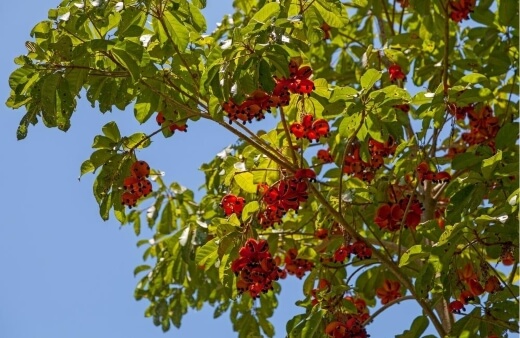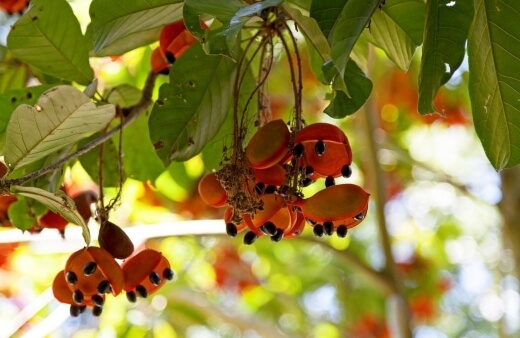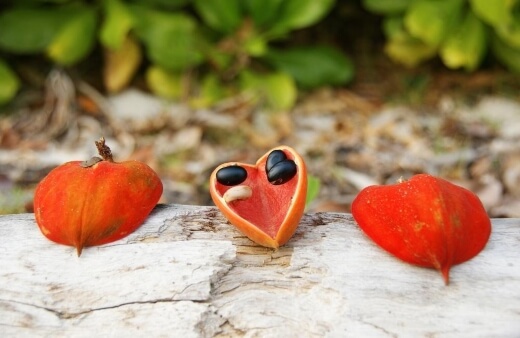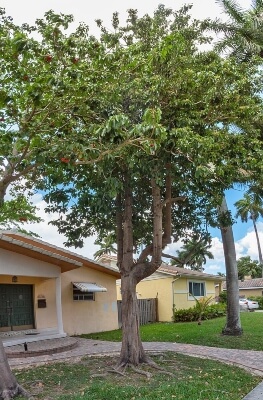The Peanut tree is a bit deceiving with its name – if you’re imagining a fresh batch of peanuts, you’re mistaken. The ‘nuts’ of this tree are actually black seeds that taste nutty, and can be eaten in a similar way that you would peanuts.
So now that we’ve cleared up the mystery around the name of the native peanut, let’s take a closer look.
In our how to grow and care guide, we’ll look at the characteristics of a Peanut tree, the right care conditions to help your tree thrive, the pests that might want to feast on your tree, what it’s like as bush tucker, and some frequently asked questions.
More...
Family: | Malvaceae |
|---|---|
Genus: | Sterculia |
Species: | S. quadrifida |
Common Names: | Peanut tree, Dundil, Red-fruited Kurrajong |
Location: | Outdoor or in pots |
Type: | Tree |
Growth: | 5-10 metres tall and 4 metres wide |
Sun requirements: | Full sun |
Foliage Colour: | Dark green |
Flower Colour: | Cream white |
Flowering: | Summer |
Fruit: | Bright orange/red with black seeds |
Maintenance level: | Average |
Poisonous for pets: | No |
Introducing the Native Peanut Tree

Peanut tree is found in Northern and Western Australia. It grows rather quickly which is great news for gardeners. The tree bark is light grey and the leaves are in a heart shape and dark green.
They tend to spread out so as the tree grows, it can produce some nice shade. If you’re living in a colder area, the tree leaves might drop off during winter. Sterculia quadrifida is not a fan of frost.
The peanut tree can grow between 5 to 10 metres tall and 4 metres in width. Once the tree is established it’s able to handle quite strong winds so it can provide a bit of a wind break.
The peanut tree is actually a rainforest plant and is related to the hibiscus and cacao. You can’t eat the pretty leaves in the same way you can the seed. In the summertime, the native peanut produces perfumed creamy white flowers.
After the flowers come the green seed pods which then turn an orange red colour and start splitting open when they are ripe. It’s a good idea to pick them before they are completely opened up.
How to Grow Peanut Trees in Australia

Source: territorynativeplants.com.au
Peanut Tree Propagation from Seed
Propagating your very own native peanut is super simple, using the seeds harvested from an existing tree. You’ll need a well-draining seed raising mixture, and you’re going to plant your seeds about 1cm deep into the potting mix.
Find a spot that gets full sun to let your seeds rest and keep the mixture moist. They germinate very quickly, usually within a number of days.
It's then up to you to decide whether you’ll be planting the seedlings in the garden, or if you plan on homing your tree in a pot. Sterculia quadrifida is equally happy with both.
Caring for Native Peanut Tree
Sunlight Preference
Who doesn't enjoy a nice big dose of Vitamin D. Sterculia quadrifida will need full sun to ensure the tree can live its best life.
Best Soil to Use
When choosing or checking your soil, you need to ensure good drainage and a neutral pH of about 6.6 to 7.3. The peanut tree can also handle poor sandy soil but well-draining is a non-negotiable.


Get Your Free Guide:
Master Growing Australian Natives eBook
A Must Have Complete Guide for Every Australian Garden
Get Your Free Guide:
Master Growing Australian Natives eBook
A Must Have Complete Guide for Every Australian Garden

Watering Red Fruited Kurrajong
The native peanut needs enough watering, so keep an eye on the soil and don’t let it dry out.
What Fertiliser to Use
Mulch is a must for Sterculia quadrifida and you can apply an organic fertiliser twice a year.
Pruning Peanut Tree
If you do enough pruning, it is possible to keep your peanut tree smaller in a pot. If you are growing it in the garden and space isn’t limited, the tree eventually offers nice shade and of course along with that come the birds and insects to visit.
Visions of a garden picnic and having the family over might come to mind.
Australian native plants are easy to grow. We have some of the most amazing varieties the world over and are quite spoiled for choice. Have a look at our Growing Australian native plants ultimate guide for plenty of inspiration.
Peanut Tree Bush Tucker Guide
The peanut tree has very eye-catching seed pods that are an orange and red colour. When the fruit is ripe, they pop open and you will see black seeds inside. These nuts as they are also called can be eaten raw or otherwise roasted.

It’s best to remove the seed skin first. In the same way that peanuts can be eaten on their own as a snack, or added to other dishes, you can do the same with the seeds of the native peanut.
Some people add them to ice cream, and you can do the same with salads. The taste of the seed is similar to macadamia, cashew, pine nut, or peanut (hence the name). To roast these delicious gems, you can pop them on the barbeque, in the oven, or even the microwave.
The Australian bush can be used to live a sustainable lifestyle and we’ve got so much to enjoy. Our Australian bush tucker articles are packed with information about how to use our native plants, fruits and trees.
Possible Peanut Tree Pests and Diseases
The native peanut is mostly pest free. However the larvae of the Tonica effractella moth like to feed on the tree. You want to get rid of the pests at the larvae stage if possible.
Use a natural insecticidal soap or an insecticide (environmentally friendly if possible) that it specially formulated to deal with moth larvae.
When it comes to pest control, we like to spare a thought for the planet too. We’re always researching the best ways to deal with pest and disease challenges, while giving the environment a breather.
Peanut Tree Frequently Asked Questions

Source: wikiwand.com
What are the Aboriginal names for the peanut tree?
Dundil (Larrakia), Malikini (Tiwi), Balkpalk (Yolngu) and for the seeds, Egng edndan (Uw Oykangand, Ow Olkola and Mayi pinta (Pakanh).
What are the many common names given to the Peanut tree?
Kuman, orange fruited kurrajong, orange fruited sterculia, red fruited kurrajong, smooth seeded kurrajong, white crowsfoot, small flowered kurrajong and monkey nuts.
Get to know more about kurrajong trees here.
Where does the name Sterculia quadrifidus come from?
Sterculia comes from the Latin word Sterculius. This is the name of the Roman god of manure! Some of the species of this plant family are rather smelly so in that way, the name makes sense.
Quadrifida comes from the word quadrifidus – it means to be split into four parts, and is supposed to make reference to the fruit of the peanut tree.
How long does it take for the Peanut tree to produce fruit and flowers?
It can take up to 5 years for the first harvest.
What are some of the uses of the Peanut tree?
The Aborigines used the tree leaves to heal wounds and stings. They also used the fibres of the bark to make kangaroo nets. The wood of the peanut tree is a light grey colour and is easy to work with due to its softness. The wood is used to make toys and boxes.
The peanut tree is part of the Malvaceae family. How many species does this family have?
About 4225 species. Some of the better known ones would be okra, cotton, and cacao.
In need of more garden inspiration? Our newsletter here is packed with tips, advice, and loads of info about everything garden related.
Get that Nice Garden Shade by Growing the Native Peanut Tree
The fruit of the peanut tree are simply marvellous to look at – a bright exterior filled with delicious black seeds that are the perfect contrast. Sterculia quadrifida is gaining popularity and becoming more known for its appearance, its shade, and it's happy go lucky way about it.
The native peanut doesn’t need a lot of maintenance and is super easy to propagate from existing seeds. You get the best of both as you get divine smelling flowers in summer and bright fruit to follow.
Sounds like a good reason to invest in Peanut tree and we’re giving it our green thumbs up.
Published on August 9, 2022 by Lorri Hopkins
Last Updated on October 4, 2024




